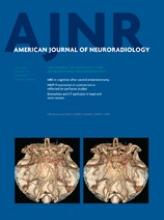Research ArticleBrain
CT Perfusion Spot Sign Improves Sensitivity for Prediction of Outcome Compared with CTA and Postcontrast CT
A. Koculym, T.J. Huynh, R. Jakubovic, L. Zhang and R.I. Aviv
American Journal of Neuroradiology May 2013, 34 (5) 965-970; DOI: https://doi.org/10.3174/ajnr.A3338
A. Koculym
aFrom the Department of Medical Imaging, University of Toronto and Sunnybrook Health Sciences Centre, Toronto, Ontario, Canada.
T.J. Huynh
aFrom the Department of Medical Imaging, University of Toronto and Sunnybrook Health Sciences Centre, Toronto, Ontario, Canada.
R. Jakubovic
aFrom the Department of Medical Imaging, University of Toronto and Sunnybrook Health Sciences Centre, Toronto, Ontario, Canada.
L. Zhang
aFrom the Department of Medical Imaging, University of Toronto and Sunnybrook Health Sciences Centre, Toronto, Ontario, Canada.
R.I. Aviv
aFrom the Department of Medical Imaging, University of Toronto and Sunnybrook Health Sciences Centre, Toronto, Ontario, Canada.

References
- 1.↵
- Morgenstern LB,
- Hemphill JC Jr.,
- Anderson C,
- et al
- 2.↵
- Russell MW,
- Joshi AV,
- Neumann PJ,
- et al
- 3.↵
- Brott T,
- Broderick J,
- Kothari R,
- et al
- 4.↵
- Leira R,
- Dávalos A,
- Silva Y,
- et al
- 5.↵
- Wada R,
- Aviv RI,
- Fox AJ,
- et al
- 6.↵
- 7.↵
- Delgado Almandoz JE,
- Yoo AJ,
- Stone MJ,
- et al
- 8.↵
- Ederies A,
- Demchuk A,
- Chia T,
- et al
- 9.↵
- Delgado Almandoz JE,
- Yoo AJ,
- Stone MJ,
- et al
- 10.↵
- 11.↵
- Chakraborty S,
- Blacquiere D,
- Lum C,
- et al
- 12.↵
- Kothari RU,
- Brott T,
- Broderick JP,
- et al
- 13.↵
- Graeb DA,
- Robertson WD,
- Lapointe JS,
- et al
- 14.↵
- Rodriguez-Luna D,
- Rubiera M,
- Ribo M,
- et al
- 15.↵
- Rabinstein AA,
- Atkinson JL,
- Wijdicks EFM
- 16.↵
- Firth D
- 17.↵
- Dowlatshahi D,
- Smith EE,
- Flaherty ML,
- et al
- 18.↵
- Mayer SA,
- Brun NC,
- Begtrup K,
- et al
- 19.↵
- Mayer SA,
- Brun NC,
- Begtrup K,
- et al
- 20.↵
- Mayer SA,
- Davis SM,
- Skolnick BE,
- et al
- 21.↵
The Spot Sign for Predicting and Treating ICH Growth Study. http://clinicaltrials.gov/ct2/results?term=The+Spot+Sign+for+Predicting+and+Treating&Search=Search. Accessed July 25, 2012.
- 22.↵
“Spot Sign” Selection of Intracerebral Hemorrhage to Guide Hemostatic Therapy (SPOTLIGHT): randomized controlled trial. ISRCTN29749408. http://clinicaltrials.gov/ct2/show/NCT00810888. Accessed July 25, 2012.
- 23.↵
- 24.↵
- d'Esterre CD,
- Chia TL,
- Jairath A,
- et al
- 25.↵
- 26.↵
- Wintermark M,
- Smith WS,
- Ko NU,
- et al
- 27.↵
- Murayama K,
- Katada K,
- Nakane M,
- et al
- 28.↵
- Yang CY,
- Chen YF,
- Lee CW,
- et al
In this issue
Advertisement
A. Koculym, T.J. Huynh, R. Jakubovic, L. Zhang, R.I. Aviv
CT Perfusion Spot Sign Improves Sensitivity for Prediction of Outcome Compared with CTA and Postcontrast CT
American Journal of Neuroradiology May 2013, 34 (5) 965-970; DOI: 10.3174/ajnr.A3338
0 Responses
Jump to section
Related Articles
Cited By...
- Tranexamic acid for acute intracerebral haemorrhage growth based on imaging assessment (TRAIGE): a multicentre, randomised, placebo-controlled trial
- Haemostatic therapy in spontaneous intracerebral haemorrhage patients with high-risk of haematoma expansion by CT marker: a systematic review and meta-analysis of randomised trials
- Timing of Occurrence Is the Most Important Characteristic of Spot Sign
- Validation of the 9-Point and 24-Point Hematoma Expansion Prediction Scores and Derivation of the PREDICT A/B Scores
- Spot Sign on 90-Second Delayed Computed Tomography Angiography Improves Sensitivity for Hematoma Expansion and Mortality: Prospective Study
- Evolution of Computed Tomography Angiography Spot Sign Is Consistent With a Site of Active Hemorrhage in Acute Intracerebral Hemorrhage
- Multicenter Accuracy and Interobserver Agreement of Spot Sign Identification in Acute Intracerebral Hemorrhage
- Imaging Recommendations for Acute Stroke and Transient Ischemic Attack Patients: A Joint Statement by the American Society of Neuroradiology, the American College of Radiology, and the Society of NeuroInterventional Surgery
This article has not yet been cited by articles in journals that are participating in Crossref Cited-by Linking.
More in this TOC Section
Similar Articles
Advertisement











